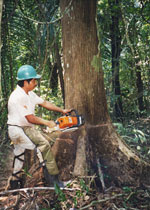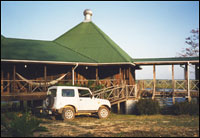Joy Grant was born in a house with no indoor plumbing in the tiny Central American country of Belize. That was 52 years ago. Last year, she accepted one of the top positions at the U.S.-based Nature Conservancy. For both parties, the marriage is a calculated gamble.

Joy, oh, Joy.
Photo: Deborah Knight.
I spent a morning with Grant recently in Belize City. Her voice has a throaty roughness to it, softened by the Belizean Creole lilt. She founded Programme for Belize, a private nonprofit conservation organization that during her 12-year tenure acquired 300,000 acres of forest land — 4 percent of the country.
Impressive as that was, the organization operated in a country the size of Massachusetts with an annual budget of just $2.5 million. The Nature Conservancy, by contrast, is a $250 million-a-year organization, and Grant was brought on as program director for one-third of its global operations: the U.S. mid-Atlantic and southern states, the Carribean, and Central America. “I had to think about that,” she said, “moving onto the world stage.”
To show me her roots, Grant drove me around Belize City. She steered with unflappable precision through its crammed streets: cars parked along either side, narrow or nonexistent sidewalks, bicycles, pushcarts, pedestrians, vendors selling bananas on the sidewalk. We passed the unpaved alley where the house in which she was born once stood (it burned down a few years ago) and the drugstore around the corner where her father worked 60 to 70 hours per week as a pharmacist.
As a child, Grant conducted much of the family’s banking and shopping, because she always negotiated the best deals. We passed her old high school, where in her senior year she was selected as “head girl” based on her grades and leadership. Her parents had the highest expectations for their three daughters, within the constraints of the world as they knew it: “Since we had only girls, my father would say, ‘I want you to be the best secretary Belize has ever seen,'” Grant told me.
After high school, Grant worked for a year for Barclay’s Bank, then went to Alberta, Canada — “a cold shock” — where she earned a bachelors degree in commerce and a masters in business administration. From there, she went to Barbados for eight years, where she worked for the Caribbean Development Bank. She approved loans for development projects in 13 Caribbean countries, but back then, she says, no one ever considered the environmental impact of a project. “For an Antigua fisheries project, we considered how many people can you employ, will they be able to pay the loan back. Whether the amount of fish you were taking was sustainable never entered into the equation.”
Grant next went to work for the Belize Embassy in Washington, D.C., where one day some people from the Massachusetts Audubon Society made a presentation to the prime minister of Belize about a proposal to buy 110,000 acres of land in Belize and turn it over to a local entity for conservation. It was Grant who kept asking questions, and the next day, she recalls, Massachusetts Audubon called her and said, “‘You caught onto this concept. We have money for a salary for three months. Would you like to start an organization to protect this land in perpetuity?'”

Sustainable logging on land
owned by Programme for Belize.
Photo: Deborah Knight.
At the time, Grant knew nothing about environmental issues. She was intrigued, however, by the idea of creating something from scratch, something that would last, as she put it, “beyond me.” She returned to Belize in 1989, assembled a board for her new organization, and got herself out into the “bush,” where she learned about birds, snakes, and red-eyed tree frogs. With help from a number of U.S. scientists and funders, including the Nature Conservancy, she aggressively acquired additional land and embarked on projects that she hoped would use a portion of the land to produce local income and jobs in an environmentally friendly manner.
Back then, the idea of sustainable development was not yet well-known, let alone well accepted, Grant says. One of her projects involved logging mahogany by cutting a limited number of trees and removing them carefully from the forest to limit damage to the surrounding ecosystem. She won two different sustainability certifications for the operation, but in the end, could barely sell the logs at all, and certainly not for any premium. She also pursued ecotourism, building cabanas and dormitories that now house visitors and school groups.
You Gotta Belize
At the Nature Conservancy, Grant is the only member of the seven-person top management team who was born outside the U.S. She sees part of her role as getting her fellow managers out “in the mud.” She took the organization’s information systems manager into the jungle in Guatemala, by helicopter, foot, boat, and car, then by boat to Belize. Now, she says, he understands why people in the field can’t be online monitoring their email all day. She took the human resources manager to Costa Rica, where they released turtle hatchlings and went into the forest to learn about the local trees. “It’s crucial,” she said, “if we are to be a global organization that the leadership understand what global means.”

The ecotourism project run by
Programme for Belize has created
jobs for locals.
Photo: Deborah Knight.
“Certain things I would take for granted that everybody knows, they don’t know,” she said. For example, in the U.S., the Nature Conservancy has long followed the model of owning land to protect it — but in developing countries, this model often doesn’t work. “I know that if you try to set large tracts of land aside in the developing world, you have to get buy-in of the local people. You cannot police it,” Grant said. Rather than recreate its original model everywhere, Grant says, the Nature Conservancy must work with local partners to develop conservation methods that involve the community. “People,” she said, “are the key to everything we do.”
Dan Campbell, the director of the Nature Conservancy’s program in Belize, worked with Grant for years when she ran Programme for Belize. He sees her entry into the Nature Conservancy’s top management as a reflection of a larger change in the organization, from simply buying land and setting it aside to a more varied approach that encourages greater involvement of local community members such as fishers, ranchers, and indigenous people. This change, he says, is occurring in the U.S. as well, although it has been driven by the organization’s international work. In this sense, he says, the tail is wagging the dog, because just 20 percent of the Nature Conservancy’s work is international. “We have an organization that sometimes tries to reduce things to models that don’t fit the culture of the nations where we work,” Campbell says. “Joy can hold up a mirror and say, ‘This doesn’t work.'”
Grant is leading the charge on a new project: development of a greater Caribbean basin marine program that would stretch from Cuba to Venezuela. The program will require the cooperation of at least 20 countries; in many of those, the Nature Conservancy doesn’t yet have a presence. “I am taking a huge risk,” Grant told me. When I asked her if she’d consulted with groups in all these countries first, she seemed surprised. No, she had simply seen the need and launched herself into the project. Now, though, she is spending a lot of time involving local people in planning the program. That, Dan Campbell told me, is vintage Joy Grant: someone willing to launch into something new, but rooted in cautious, methodical implementation.
On the wall in Grant’s part-time office in Belize hangs a line drawing of a tropical tree draped with vines. Young sprouts erupt from its trunk, but a thick buttress holds it solidly in place. “I think I know that tree,” Grant told me. “It’s a mahogany.” I couldn’t help but see a resemblance.


